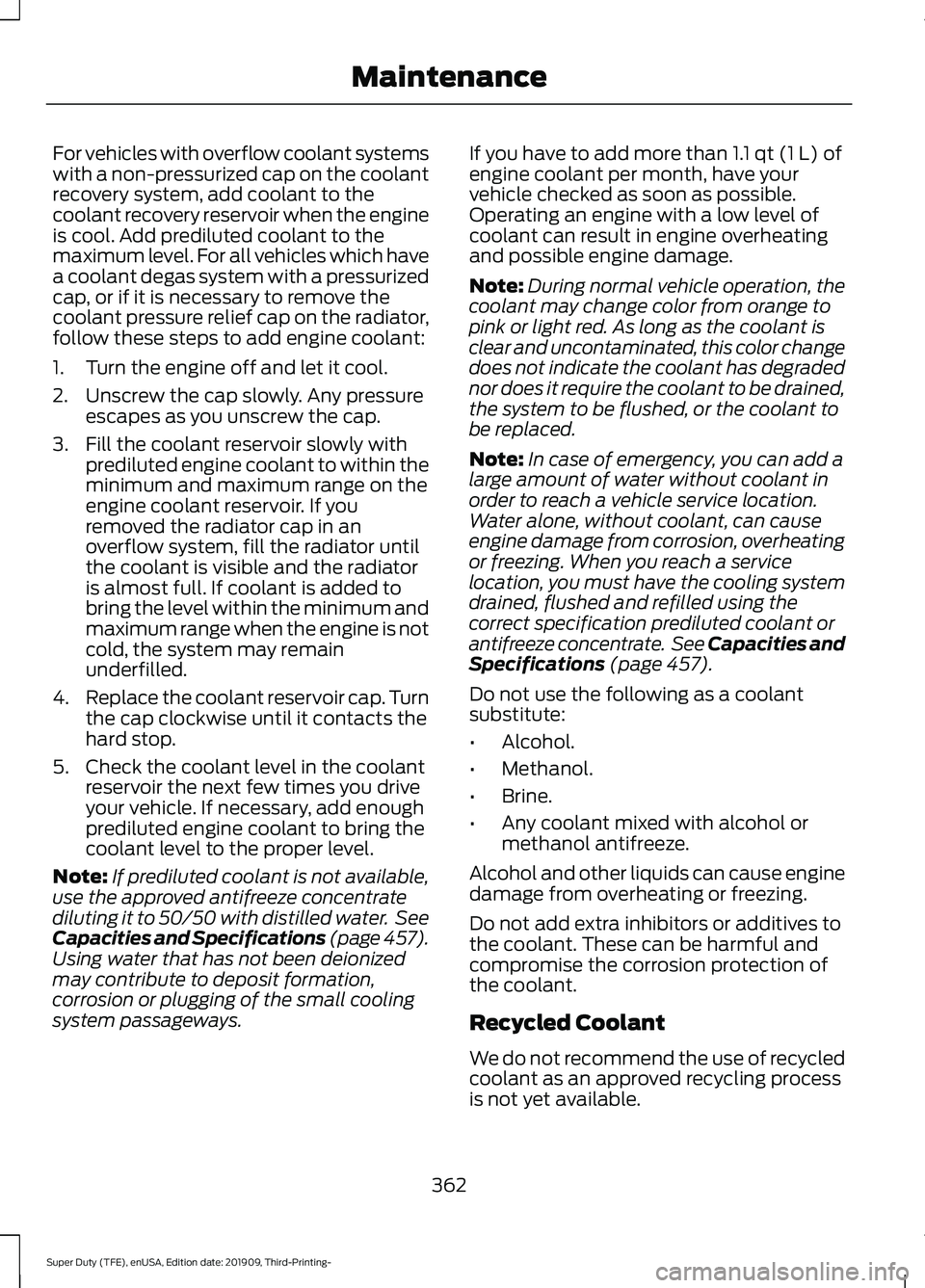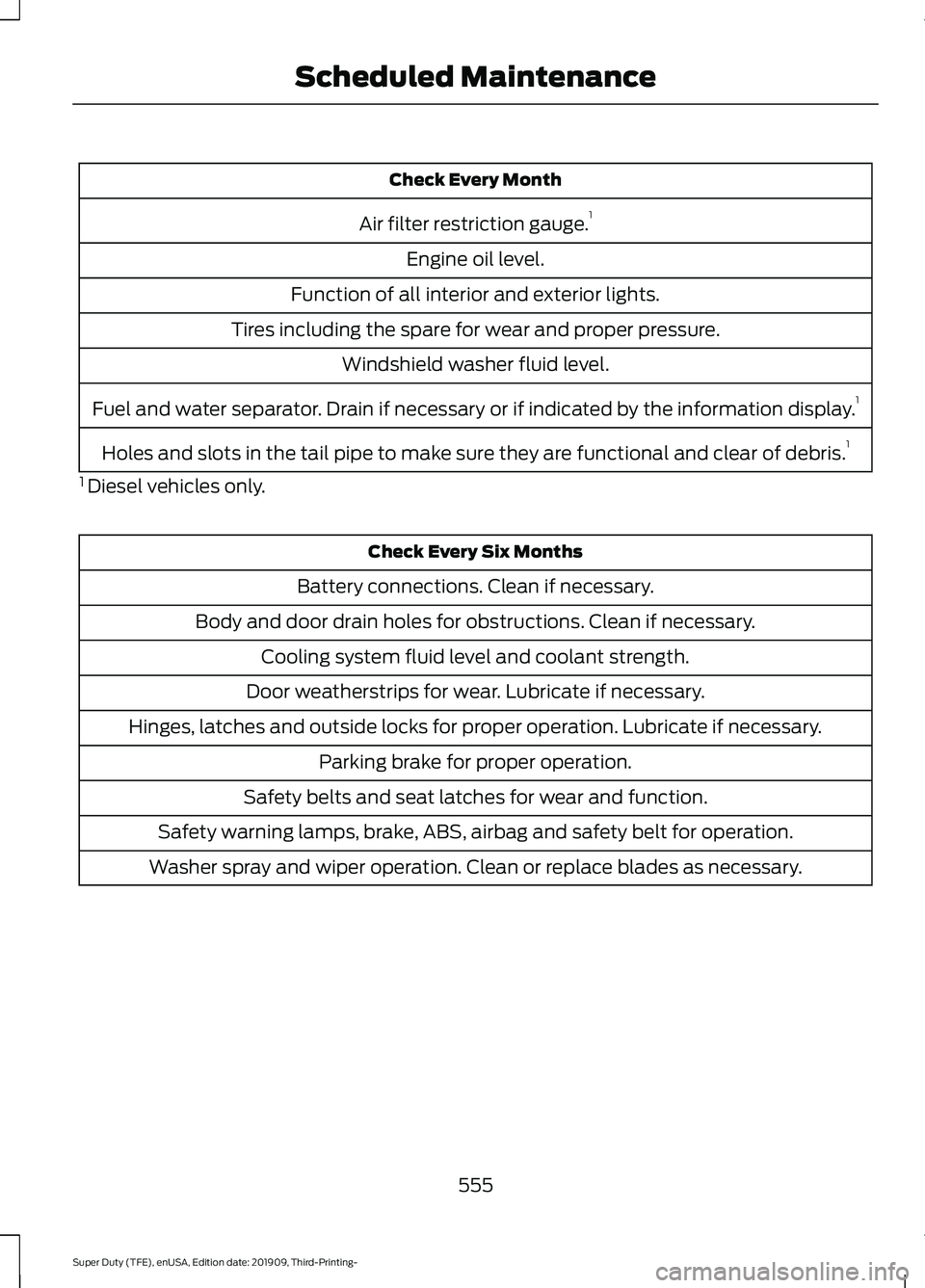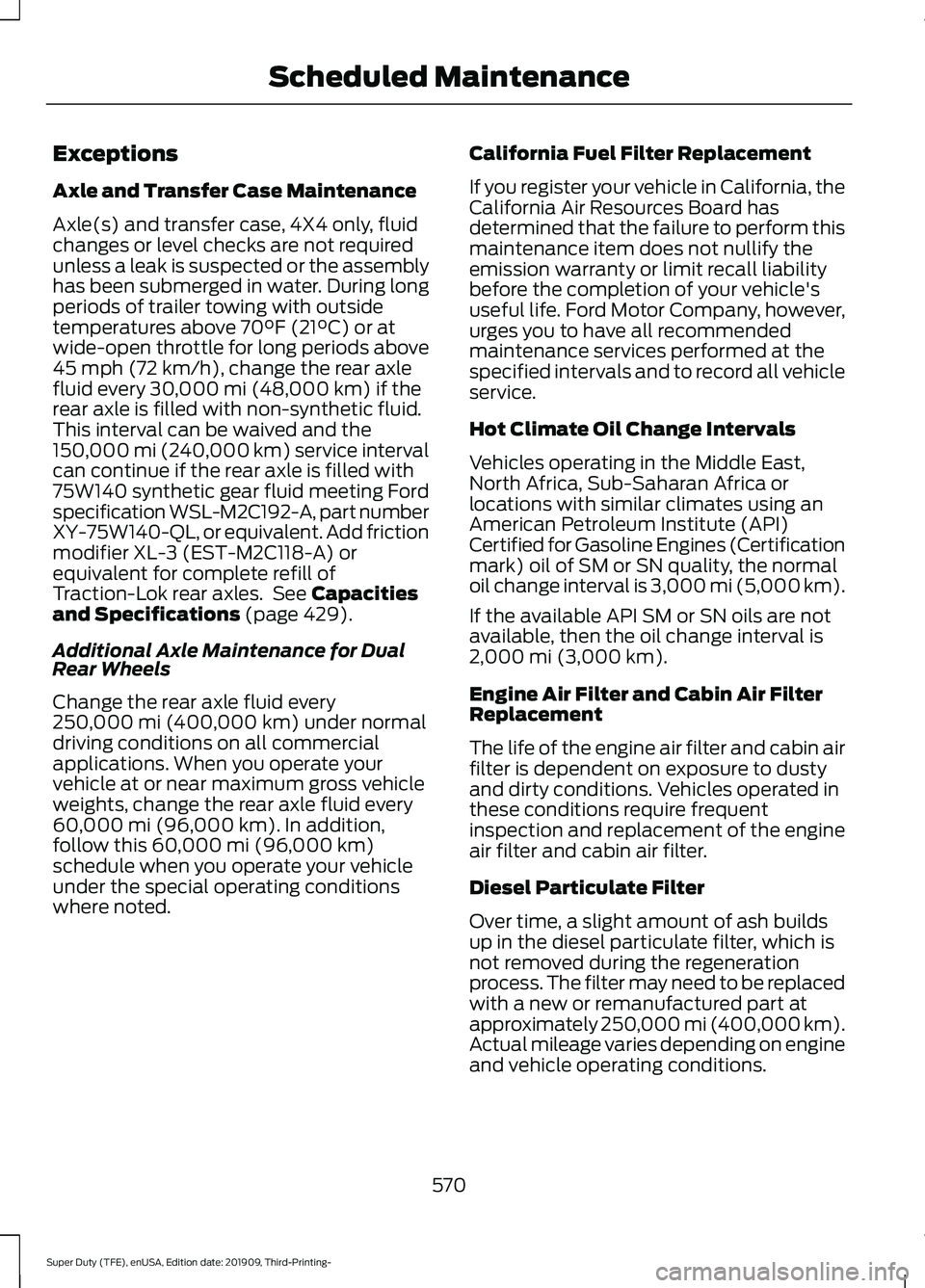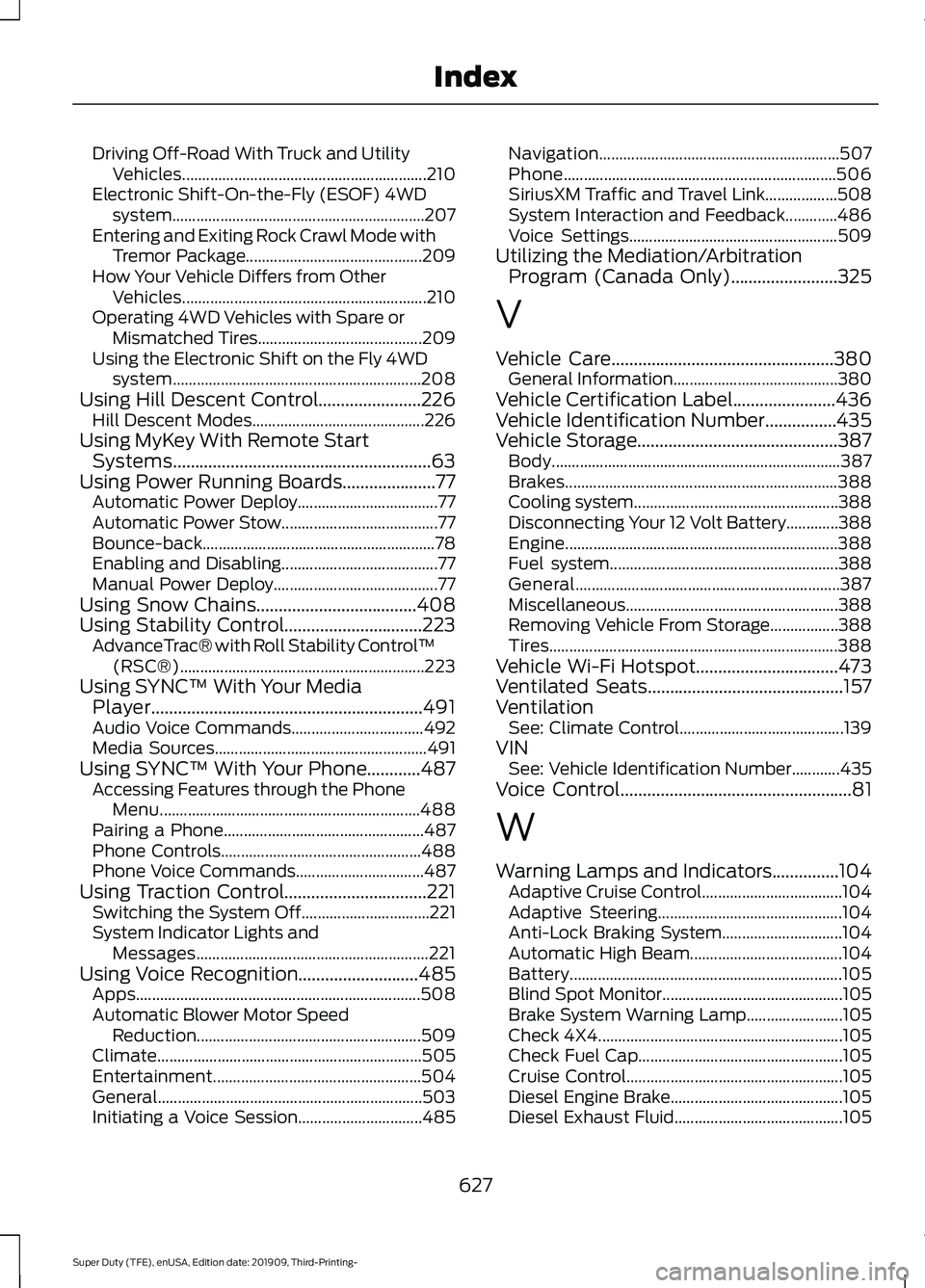check engine light FORD F-550 2020 Owner's Manual
[x] Cancel search | Manufacturer: FORD, Model Year: 2020, Model line: F-550, Model: FORD F-550 2020Pages: 631, PDF Size: 9.62 MB
Page 365 of 631

For vehicles with overflow coolant systems
with a non-pressurized cap on the coolant
recovery system, add coolant to the
coolant recovery reservoir when the engine
is cool. Add prediluted coolant to the
maximum level. For all vehicles which have
a coolant degas system with a pressurized
cap, or if it is necessary to remove the
coolant pressure relief cap on the radiator,
follow these steps to add engine coolant:
1. Turn the engine off and let it cool.
2. Unscrew the cap slowly. Any pressure
escapes as you unscrew the cap.
3. Fill the coolant reservoir slowly with prediluted engine coolant to within the
minimum and maximum range on the
engine coolant reservoir. If you
removed the radiator cap in an
overflow system, fill the radiator until
the coolant is visible and the radiator
is almost full. If coolant is added to
bring the level within the minimum and
maximum range when the engine is not
cold, the system may remain
underfilled.
4. Replace the coolant reservoir cap. Turn
the cap clockwise until it contacts the
hard stop.
5. Check the coolant level in the coolant reservoir the next few times you drive
your vehicle. If necessary, add enough
prediluted engine coolant to bring the
coolant level to the proper level.
Note: If prediluted coolant is not available,
use the approved antifreeze concentrate
diluting it to 50/50 with distilled water. See
Capacities and Specifications (page 457).
Using water that has not been deionized
may contribute to deposit formation,
corrosion or plugging of the small cooling
system passageways. If you have to add more than
1.1 qt (1 L) of
engine coolant per month, have your
vehicle checked as soon as possible.
Operating an engine with a low level of
coolant can result in engine overheating
and possible engine damage.
Note: During normal vehicle operation, the
coolant may change color from orange to
pink or light red. As long as the coolant is
clear and uncontaminated, this color change
does not indicate the coolant has degraded
nor does it require the coolant to be drained,
the system to be flushed, or the coolant to
be replaced.
Note: In case of emergency, you can add a
large amount of water without coolant in
order to reach a vehicle service location.
Water alone, without coolant, can cause
engine damage from corrosion, overheating
or freezing. When you reach a service
location, you must have the cooling system
drained, flushed and refilled using the
correct specification prediluted coolant or
antifreeze concentrate. See
Capacities and
Specifications (page 457).
Do not use the following as a coolant
substitute:
• Alcohol.
• Methanol.
• Brine.
• Any coolant mixed with alcohol or
methanol antifreeze.
Alcohol and other liquids can cause engine
damage from overheating or freezing.
Do not add extra inhibitors or additives to
the coolant. These can be harmful and
compromise the corrosion protection of
the coolant.
Recycled Coolant
We do not recommend the use of recycled
coolant as an approved recycling process
is not yet available.
362
Super Duty (TFE), enUSA, Edition date: 201909, Third-Printing- Maintenance
Page 558 of 631

Check Every Month
Air filter restriction gauge. 1
Engine oil level.
Function of all interior and exterior lights.
Tires including the spare for wear and proper pressure. Windshield washer fluid level.
Fuel and water separator. Drain if necessary or if indicated by the information display. 1
Holes and slots in the tail pipe to make sure they are functional and clear of debris. 1
1 Diesel vehicles only. Check Every Six Months
Battery connections. Clean if necessary.
Body and door drain holes for obstructions. Clean if necessary. Cooling system fluid level and coolant strength.
Door weatherstrips for wear. Lubricate if necessary.
Hinges, latches and outside locks for proper operation. Lubricate if necessary. Parking brake for proper operation.
Safety belts and seat latches for wear and function.
Safety warning lamps, brake, ABS, airbag and safety belt for operation.
Washer spray and wiper operation. Clean or replace blades as necessary.
555
Super Duty (TFE), enUSA, Edition date: 201909, Third-Printing- Scheduled Maintenance
Page 573 of 631

Exceptions
Axle and Transfer Case Maintenance
Axle(s) and transfer case, 4X4 only, fluid
changes or level checks are not required
unless a leak is suspected or the assembly
has been submerged in water. During long
periods of trailer towing with outside
temperatures above 70°F (21°C) or at
wide-open throttle for long periods above
45 mph (72 km/h)
, change the rear axle
fluid every 30,000 mi (48,000 km) if the
rear axle is filled with non-synthetic fluid.
This interval can be waived and the
150,000 mi (240,000 km) service interval
can continue if the rear axle is filled with
75W140 synthetic gear fluid meeting Ford
specification WSL-M2C192-A, part number
XY-75W140-QL, or equivalent. Add friction
modifier XL-3 (EST-M2C118-A) or
equivalent for complete refill of
Traction-Lok rear axles. See
Capacities
and Specifications (page 429).
Additional Axle Maintenance for Dual
Rear Wheels
Change the rear axle fluid every
250,000 mi (400,000 km)
under normal
driving conditions on all commercial
applications. When you operate your
vehicle at or near maximum gross vehicle
weights, change the rear axle fluid every
60,000 mi (96,000 km)
. In addition,
follow this 60,000 mi (96,000 km)
schedule when you operate your vehicle
under the special operating conditions
where noted. California Fuel Filter Replacement
If you register your vehicle in California, the
California Air Resources Board has
determined that the failure to perform this
maintenance item does not nullify the
emission warranty or limit recall liability
before the completion of your vehicle's
useful life. Ford Motor Company, however,
urges you to have all recommended
maintenance services performed at the
specified intervals and to record all vehicle
service.
Hot Climate Oil Change Intervals
Vehicles operating in the Middle East,
North Africa, Sub-Saharan Africa or
locations with similar climates using an
American Petroleum Institute (API)
Certified for Gasoline Engines (Certification
mark) oil of SM or SN quality, the normal
oil change interval is 3,000 mi (5,000 km).
If the available API SM or SN oils are not
available, then the oil change interval is
2,000 mi (3,000 km)
.
Engine Air Filter and Cabin Air Filter
Replacement
The life of the engine air filter and cabin air
filter is dependent on exposure to dusty
and dirty conditions. Vehicles operated in
these conditions require frequent
inspection and replacement of the engine
air filter and cabin air filter.
Diesel Particulate Filter
Over time, a slight amount of ash builds
up in the diesel particulate filter, which is
not removed during the regeneration
process. The filter may need to be replaced
with a new or remanufactured part at
approximately 250,000 mi (400,000 km).
Actual mileage varies depending on engine
and vehicle operating conditions.
570
Super Duty (TFE), enUSA, Edition date: 201909, Third-Printing- Scheduled Maintenance
Page 630 of 631

Driving Off-Road With Truck and Utility
Vehicles............................................................. 210
Electronic Shift-On-the-Fly (ESOF) 4WD system............................................................... 207
Entering and Exiting Rock Crawl Mode with Tremor Package............................................ 209
How Your Vehicle Differs from Other Vehicles............................................................. 210
Operating 4WD Vehicles with Spare or Mismatched Tires......................................... 209
Using the Electronic Shift on the Fly 4WD system.............................................................. 208
Using Hill Descent Control.......................226 Hill Descent Modes........................................... 226
Using MyKey With Remote Start Systems..........................................................63
Using Power Running Boards.....................77 Automatic Power Deploy................................... 77
Automatic Power Stow....................................... 77
Bounce-back.......................................................... 78
Enabling and Disabling....................................... 77
Manual Power Deploy......................................... 77
Using Snow Chains....................................408
Using Stability Control...............................223 AdvanceTrac® with Roll Stability Control ™
(RSC®)............................................................. 223
Using SYNC™ With Your Media Player.............................................................491
Audio Voice Commands................................. 492
Media Sources..................................................... 491
Using SYNC™ With Your Phone............487 Accessing Features through the Phone
Menu................................................................. 488
Pairing a Phone.................................................. 487
Phone Controls.................................................. 488
Phone Voice Commands................................ 487
Using Traction Control................................221 Switching the System Off................................ 221
System Indicator Lights and Messages.......................................................... 221
Using Voice Recognition...........................485
Apps....................................................................... 508
Automatic Blower Motor Speed Reduction........................................................ 509
Climate.................................................................. 505
Entertainment.................................................... 504
General.................................................................. 503
Initiating a Voice Session............................... 485Navigation............................................................
507
Phone.................................................................... 506
SiriusXM Traffic and Travel Link.................. 508
System Interaction and Feedback.............486
Voice Settings.................................................... 509
Utilizing the Mediation/Arbitration Program (Canada Only)........................325
V
Vehicle Care..................................................380 General Information......................................... 380
Vehicle Certification Label.......................436
Vehicle Identification Number................435
Vehicle Storage
.............................................387
Body........................................................................\
387
Brakes.................................................................... 388
Cooling system................................................... 388
Disconnecting Your 12 Volt Battery.............388
Engine.................................................................... 388
Fuel system......................................................... 388
General.................................................................. 387
Miscellaneous ..................................................... 388
Removing Vehicle From Storage.................388
Tires........................................................................\
388
Vehicle Wi-Fi Hotspot
................................473
Ventilated Seats............................................157
Ventilation See: Climate Control......................................... 139
VIN See: Vehicle Identification Number............435
Voice Control
....................................................81
W
Warning Lamps and Indicators...............104 Adaptive Cruise Control................................... 104
Adaptive Steering.............................................. 104
Anti-Lock Braking System.............................. 104
Automatic High Beam...................................... 104
Battery.................................................................... 105
Blind Spot Monitor............................................. 105
Brake System Warning Lamp........................ 105
Check 4X4............................................................. 105
Check Fuel Cap................................................... 105
Cruise Control...................................................... 105
Diesel Engine Brake........................................... 105
Diesel Exhaust Fluid.......................................... 105
627
Super Duty (TFE), enUSA, Edition date: 201909, Third-Printing- Index